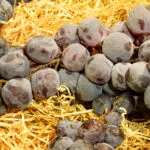

Italy - Aosta Valley
Production
Valais & Vaud : 145 Hectares
99% Valais - 1% Vaud
Operating temperature
14 - 16°C
Food pairing
Red or white meats, game dishes, Desserts based on red or black fruit, Vegetable Tian
Ruby with purple highlights

Main aromas

Red and black fruit

Spices
About Humagne Rouge
Unrelated to Humagne Blanche, Humagne Rouge was introduced to Valais (Switzerland) from Valle d'Aosta (Italy) towards the end of the XIXᵉ century. Long confused with Petit Rouge d'Aoste, this grape variety was identified in 1999 as actually the Cornalin d'AosteThe result of enzymatic and genetic analyses. Prior to this discovery, it had taken the name of Rouge du Pays in 1972.
Humagne Rouge is the result of a natural cross-breeding in the Val d'Aoste region between Rouge du Pays and an as yet unknown grape variety. In Switzerland, it is grown almost exclusively in the Valais region, where it has become an emblem of local viticulture.
Aromas and characteristics of Humagne Rouge
Wine characteristics :
- Dress A deep ruby red color, sometimes slightly purplish in its youth.
- Structure A fine acidity that gives it freshness and balance, often accompanied by a marked but fine tannic structure.
- Body Supple to medium-bodied, with a harmonious texture.
- Evolution Humagne Rouge is a wine that ages well. Over time, its tannins soften and its aromas evolve towards more complex notes of leather and undergrowth.
- Wine and food pairing Ideal with game (such as venison or wild boar), grilled red meats, simmered dishes or alpine cheeses.
Varietal character :
- Humagne Rouge is often referred to as a "mountain wine" because of its perfect adaptation to Valais terroirs and its personality that reflects the rugged beauty of the Alps.
Can Humagne Rouge be kept for a long time?
The ageing potential of Humagne Rouge depends on its style. Barrel-aged vintages, rich in tannins and body, lend themselves well to aging, reaching their full potential after 8 to 12 years. On the other hand, a lighter, fruitier Humagne Rouge aged in stainless steel tanks is ideal for drinking young, within 1 to 5 years. Over time, its fruity aromas transform into more complex notes of leather, tobacco and damp earth, promising a tasting full of character and subtlety.






